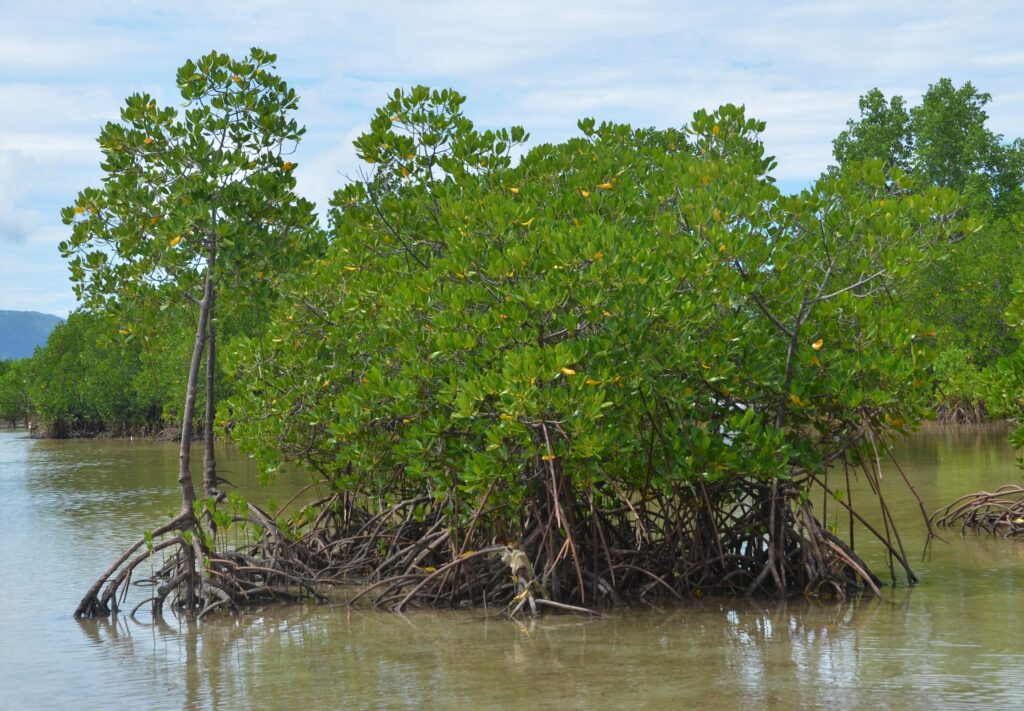Text and Photos by Henrylito D. Tacio
“Mangroves are like the kindergarten, seagrasses are the secondary schools, and coral reefs are the high schools and colleges for fishes! And, once (the fishes) graduate from university, they return to kindergarten to spawn.” – Khun Psit, cofounder of Thailand’s Yad Fon mangrove preservation project
“All over the country, whatever coastal province you visit, you see the same plight – desolate stretches of shoreline completely stripped of mangrove cover and now totally exposed to the pounding of the ocean’s waves,” observes Dr. Miguel D. Fortes, the first Filipino to receive the prestigious International Biwako Prize for Ecology.
Mangroves are cut down for various reasons. “Mangrove forest cover in the Philippines has declined substantially during this century,” wrote Alan T. White and Roy Olsen D. de Leon, who were once involved in some initiatives: Coastal Resource Management Project and Silliman University Marine Laboratory, respectively.
The two, who penned a collaborative report, said that only 150,000 hectares of mangroves remain of the 450,000 hectares reported in 1918, the most rapid decrease occurring during the 1960s and 1970s when government policies encouraged the expansion of aquaculture.
In their report, the two said the fishponds covered about 289,000 hectares, most of which are in areas once shielded with mangroves. This expansion occurred largely during a period when real prices for fish and shrimp were steadily increasing.
Despite a 1980 government ban on further conversion of mangroves to fishponds, the reduction of mangrove area since that year through 1991 continued at the annual rate of about 3,700 hectares in the following decade. This decline parallels the increase of fishpond area, approximately 41,000 hectares per year over the same period.
The conversion of mangrove areas to fishponds is the final step in a process of destruction that started with the over-harvesting of mangroves for fuelwood, frequently by persons other than those who ultimately built the fishponds.
“Cutting of mangroves for fuelwood, charcoal making and construction is probably the second most pervasive intrusion on the resource,” White and de Leon claimed.
Small bakeries, for instance, prefer mangrove wood. The demand for these products leads to illegal cutting, over-harvesting, and subsequent degradation of the habitat and ecosystem. “This, in turn, contributes to the decline of nearshore fisheries. Degraded areas are more easily reclassified as disposable lands, which makes conversion more likely,” the two noted.
The economic boom has also contributed to the denudation of mangrove forests. “Mangrove areas are the site for reclamation for urbanization and human settlements, expansion of highways, ports, and factories, and tourism and recreational facilities,” said Prof. Rodolfo B. Baldevarona of the University of the Philippines-Visayas (UPV). “As human settlement, mangrove is preferred because of its proximity to the sea and the fisheries along the shoreline.”
Dr. Fortes says mangrove forests occupy “the area of the coastal zone between the mean sea level and extreme high water of spring tides.” They thrive in sheltered tidal flats, coves, bays, and river estuaries. Generally, mangroves are associated with thick stands of medium-sized and even-aged trees, nipa palms, and other plants.
Around the world, there are 54 species of true mangroves (34 major and 20 minor) and 60 mangrove associates. True mangrove species are those that strictly grow in the mangrove environment, while associated species may thrive on other habitat types such as beach forest and lowland areas.


The Philippines has around 47 “true mangroves” and associated species belonging to 26 families. Most of the remaining mangroves can be found in Mindanao (29% of the total), and the remaining can be found in Luzon and Mindoro. Old-growth mangrove forests are mainly located in Mindanao and Palawan.
Dr. Rafael D. Guerrero III, an academician with the National Academy of Science and Technology, urged Filipinos to stop the wanton destruction of the country’s mangroves.
“Because of the interconnectivity between mangroves, seagrass beds and coral reefs, the loss of one will cause the decline in productivity of the others,” he explained. “Fisheries production in our coastal waters will consequently decline. Since mangroves also serve as a buffer zone or protection against wind and wave action on our shoreline, there will be more shore erosion and exposure with their loss.”
Unknowingly, mangroves offer a wide array of multifarious benefits. For one, they are important sources of both major and minor forest products. The major forest products include timber, firewood, charcoal, and pulp and paper, whereas the minor products derived are extractives (tannin and dyes), nipa sap and nipa shingles, oil, medicine, resin, tea, and livestock supplements.
Timber products from mangroves are poles, house post foundation, pilings, bridges, ship planking, and mine timber props. Wood quality is excellent for making furniture and tool handles.
In rural areas, firewood and charcoal from mangroves are used in cooking, heating, and ironing. “Bakuan” (Rhizophora spp.) is considered the best for charcoal making compared to those derived from any Philippine hardwood species because of its high calorific value and emission of very little smoke. “Bakuan” is also excellent for firewood.
But most importantly, mangroves serve as nursery grounds for fishes and other fishery products.
Mangroves are very important to marine life. They are home to 68 species of fish (including bangus, kitan, and mullet, to name a few), 54 species of crustaceans (shrimps, prawns, and crabs), and 56 species of gastropods.
Fisheries associated with mangrove forests, much of it collected by the poorest of the poor, contribute some 0.67 tons per hectare of mangrove forest per year to total fisheries.
“Mangroves support the natural food chain by forming a link between the land and the sea,” Prof. Baldevarona wrote in his article, The Role of Mangrove in the Philippine Coastal Environment. “They serve as the sanctuary of both aquatic and terrestrial wildlife. Other forms of life are extremely dependent on mangroves.”
Despite the various benefits that mangroves offer, they are indiscriminately exploited, distorting their existing ecological balance and stability. “The rate at which people destroy the mangrove resource is alarming,” Prof. Baldevarona deplored.

